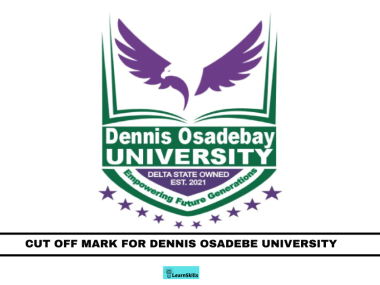If you are aiming for admission into Alex Ekwueme Federal University Ndufu-Alike (FUNAI), knowing the cut-off marks is crucial for your application. For the 2025/2026 academic session, the general JAMB cut-off mark for FUNAI is set at 150.
For example, competitive programs like Medicine require a much higher score of at least 220, while other fields such as Agriculture may accept students with a lower score of 150.
Understanding these cut-off marks can help you develop a strategic plan for your JAMB exam and overall application process.
Admission Criteria in Nigerian Higher Education
In Nigeria, gaining admission into higher education involves several important steps. You need to understand the roles of the Joint Admissions and Matriculation Board (JAMB) and how universities assess candidates through post-UTME and specific academic requirements.
Understanding JAMB and its Role
JAMB is essential for university admission in Nigeria. This board conducts the Unified Tertiary Matriculation Examination (UTME) annually. To apply for admission, you need to register for this exam.
Here are some key points about JAMB:
- Cut-Off Marks: Each university sets its cut-off mark. For instance, AE-FUNAI has a general mark of 150, but certain courses require higher scores.
- Score Submission: After the exam, your scores are forwarded to universities for consideration during the admission process.
- Eligibility: Your subject combination in UTME must align with your desired course. Check the requirements carefully.
Understanding JAMB is crucial as your performance here directly impacts your chances of getting admission.
Post-UTME and University-Specific Requirements
After passing the UTME, many universities require an additional screening called post-UTME. This helps schools assess candidates more rigorously.
- Screening Tests: Some schools use written tests or interviews, while others may evaluate your O’Level results.
- Departmental Cut-Offs: Each department, like Medicine or Law, may have specific cut-off marks. For example, Law may need a minimum of 220, while Agriculture could start at 150.
- Documents Needed: Prepare necessary documents, including your JAMB result, O’Level certificates, and any other forms required by the university.
Fulfilling these requirements is essential to secure your admission into your chosen program.
Overview of Federal University Cut-off Marks
Cut-off marks play a crucial role in the admission process for federal universities in Nigeria.
Regional Admission Preferences
Federal universities often have regional admission preferences based on student demographics. For example, universities like the University of Ilorin may prioritize students from Kwara State or neighboring areas. This can affect your chances if you are an out-of-state candidate.
Different regions may also have varying cut-off marks depending on the competition for popular courses.
Institutions might adjust their requirements based on local performance in exams, such as JAMB, to encourage more applicants from underrepresented areas.
Common Cut-off Range for Competitive Universities
Many federal universities set their cut-off marks based on national averages and course competitiveness. Generally, cut-off marks for federal universities in Nigeria can range from 140 to 250, depending on the program.
For example, competitive courses like Medicine may require a higher cut-off of 220 or above, while less sought-after programs might have lower thresholds, often starting at 150.
Here’s a simple breakdown of cut-off marks:
- Medicine: 220+
- Law: 220+
- Engineering: 180+
- General Arts: 150+
This range highlights the need to check specific requirements for your desired program at the university of your choice.
Federal University of Technology Specialties
Federal Universities of Technology generally focus on engineering and technological courses. Institutions like the Federal University of Technology will often set cut-off marks that reflect the specialized nature of their programs.
For instance, these universities may have a minimum cut-off mark of 200 for engineering-related courses.
It’s important to note that some programs may also have additional requirements, like entrance exams or interviews, which can affect the admission process. Be sure to research the specific cut-off marks for the course you’re interested in to ensure you meet all criteria.
State Universities and Varied Cut-off Marks
State universities in Nigeria have different cut-off marks depending on various factors.
Influence of State Policies on Admission Standards
State policies significantly shape the admission standards of universities. For instance, universities like Lagos State University (LASU) and Ekiti State University often adapt their cut-off marks based on government recommendations and educational targets.
LASU generally sets a cut-off mark of around 200, reflecting a competitive environment in programs such as Law and Medicine. In contrast, Ekiti State University may have lower cut-off marks, often around 150, to attract more applicants.
This variation means you should check each institution’s requirements closely. State policies can change, affecting the admissions landscape each year.
Cut-off Trends in Popular State Universities
Cut-off marks vary widely among popular state universities based on demand and available programs. For example, Enugu State University of Science and Technology typically sets its cut-off at 160 for some courses, while it may rise to 200 or higher for more competitive programs.
Here’s a quick overview of cut-off marks for selected state universities:
| University | Cut-off Mark |
|---|---|
| Lagos State University (LASU) | 200 |
| Ekiti State University | 150 |
| Enugu State University of Science | 160 |
This trend illustrates the importance of knowing specific university requirements. Always stay updated with official announcements to ensure you meet the necessary criteria for your desired program.
Comparison Between Federal and State University Admission
When considering admission into universities, you will notice key differences between federal and state universities, especially regarding cut-off marks.
Federal universities often have more standardized requirements, while state universities may offer flexible admission criteria.
Federal Universities as a Benchmark
Federal universities, such as the Federal University of Technology and the University of Lagos (UNILAG), often set higher cut-off marks.
For instance, the cut-off for competitive courses like Medicine and Law can reach as high as 220 and 240, respectively. This is mainly due to their broader recognition and the high demand for limited spaces.
These universities provide a uniform standard across various states, which helps maintain quality. Also, the admission processes are governed by centralized examinations, like the Unified Tertiary Matriculation Examination (UTME).
State Universities’ Flexibility in Cut-off Marks
In contrast, state universities, such as the University of Nigeria, Nsukka (UNN), tend to have more flexible admission standards. Their cut-off marks can range significantly.
For example, some programs may accept students with cut-off marks as low as 150, particularly in less competitive fields.
State universities assess local applicants and often consider other factors, such as state of origin and other qualifications. This flexibility can make it easier for some students to gain admission, especially those who may not achieve the high scores needed for federal institutions.
Anticipating Future Trends in Admission Benchmarks
As you navigate the admission landscape, understanding how cut-off marks may evolve is crucial. Changes in policies and student strategies can significantly shape these benchmarks.
Policy Changes and Impact on Cut-off Marks
Government policies and regulations play a vital role in determining cut-off marks for universities like FUNAI. The Joint Admissions and Matriculation Board (JAMB) sets minimum scores. For example, JAMB cut-off marks for universities are currently at 140.
In response, universities may adjust their own thresholds based on applicant performance and competition.
You should stay updated on these changes. Monitor announcements from JAMB and FUNAI regarding any adjustments in requirements. These adjustments can directly impact your eligibility for admission into degree courses.
Adaptive Strategies for Prospective Students
To improve your chances of meeting or exceeding cut-off marks, consider adopting several strategies. First, focus on preparing for the JAMB and post-UTME exams. A solid study plan can help you achieve high scores.
Joining study groups can also provide support and motivation. Engaging with peers allows you to share knowledge and strategies for success.
Lastly, review the admission trends and requirements regularly. Universities may release updates on their specific criteria or changes in cut-off marks. By preparing early and staying informed, you can enhance your chances of gaining admission to FUNAI.









